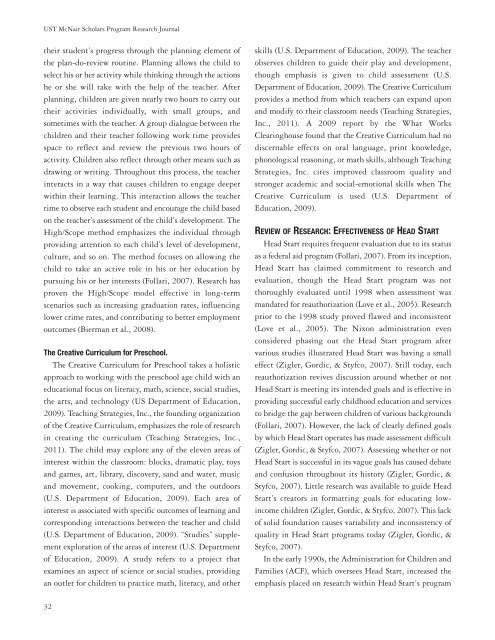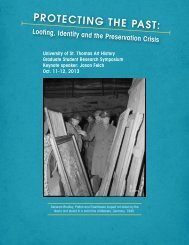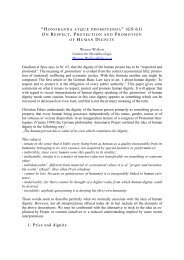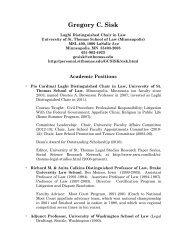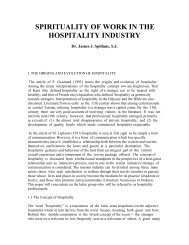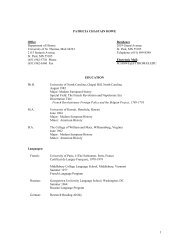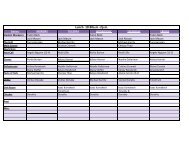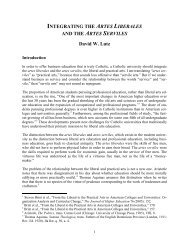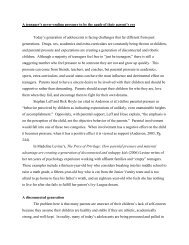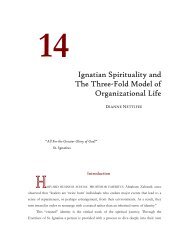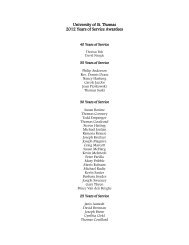dr. ronald e. mcnair acknowledgements - University of St. Thomas
dr. ronald e. mcnair acknowledgements - University of St. Thomas
dr. ronald e. mcnair acknowledgements - University of St. Thomas
You also want an ePaper? Increase the reach of your titles
YUMPU automatically turns print PDFs into web optimized ePapers that Google loves.
UST McNair Scholars Program Research Journal<br />
their student’s progress through the planning element <strong>of</strong><br />
the plan-do-review routine. Planning allows the child to<br />
select his or her activity while thinking through the actions<br />
he or she will take with the help <strong>of</strong> the teacher. After<br />
planning, chil<strong>dr</strong>en are given nearly two hours to carry out<br />
their activities individually, with small groups, and<br />
sometimes with the teacher. A group dialogue between the<br />
chil<strong>dr</strong>en and their teacher following work time provides<br />
space to reflect and review the previous two hours <strong>of</strong><br />
activity. Chil<strong>dr</strong>en also reflect through other means such as<br />
<strong>dr</strong>awing or writing. Throughout this process, the teacher<br />
interacts in a way that causes chil<strong>dr</strong>en to engage deeper<br />
within their learning. This interaction allows the teacher<br />
time to observe each student and encourage the child based<br />
on the teacher’s assessment <strong>of</strong> the child’s development. The<br />
High/Scope method emphasizes the individual through<br />
providing attention to each child’s level <strong>of</strong> development,<br />
culture, and so on. The method focuses on allowing the<br />
child to take an active role in his or her education by<br />
pursuing his or her interests (Follari, 2007). Research has<br />
proven the High/Scope model effective in long-term<br />
scenarios such as increasing graduation rates, influencing<br />
lower crime rates, and contributing to better employment<br />
outcomes (Bierman et al., 2008).<br />
The Creative Curriculum for Preschool.<br />
The Creative Curriculum for Preschool takes a holistic<br />
approach to working with the preschool age child with an<br />
educational focus on literacy, math, science, social studies,<br />
the arts, and technology (US Department <strong>of</strong> Education,<br />
2009). Teaching <strong>St</strong>rategies, Inc., the founding organization<br />
<strong>of</strong> the Creative Curriculum, emphasizes the role <strong>of</strong> research<br />
in creating the curriculum (Teaching <strong>St</strong>rategies, Inc.,<br />
2011). The child may explore any <strong>of</strong> the eleven areas <strong>of</strong><br />
interest within the classroom: blocks, <strong>dr</strong>amatic play, toys<br />
and games, art, library, discovery, sand and water, music<br />
and movement, cooking, computers, and the outdoors<br />
(U.S. Department <strong>of</strong> Education, 2009). Each area <strong>of</strong><br />
interest is associated with specific outcomes <strong>of</strong> learning and<br />
corresponding interactions between the teacher and child<br />
(U.S. Department <strong>of</strong> Education, 2009). “<strong>St</strong>udies” supple -<br />
ment exploration <strong>of</strong> the areas <strong>of</strong> interest (U.S. Department<br />
<strong>of</strong> Education, 2009). A study refers to a project that<br />
examines an aspect <strong>of</strong> science or social studies, providing<br />
an outlet for chil<strong>dr</strong>en to practice math, literacy, and other<br />
32<br />
skills (U.S. Department <strong>of</strong> Education, 2009). The teacher<br />
observes chil<strong>dr</strong>en to guide their play and development,<br />
though emphasis is given to child assessment (U.S.<br />
Department <strong>of</strong> Education, 2009). The Creative Curriculum<br />
provides a method from which teachers can expand upon<br />
and modify to their classroom needs (Teaching <strong>St</strong>rategies,<br />
Inc., 2011). A 2009 report by the What Works<br />
Clearinghouse found that the Creative Curriculum had no<br />
discernable effects on oral language, print knowledge,<br />
phonological reasoning, or math skills, although Teaching<br />
<strong>St</strong>rategies, Inc. cites improved classroom quality and<br />
stronger academic and social-emotional skills when The<br />
Creative Curriculum is used (U.S. Department <strong>of</strong><br />
Education, 2009).<br />
REVIEW OF RESEARCH: EFFECTIVENESS OF HEAD START<br />
Head <strong>St</strong>art requires frequent evaluation due to its status<br />
as a federal aid program (Follari, 2007). From its inception,<br />
Head <strong>St</strong>art has claimed commitment to research and<br />
evaluation, though the Head <strong>St</strong>art program was not<br />
thoroughly evaluated until 1998 when assessment was<br />
mandated for reauthorization (Love et al., 2005). Research<br />
prior to the 1998 study proved flawed and inconsistent<br />
(Love et al., 2005). The Nixon administration even<br />
considered phasing out the Head <strong>St</strong>art program after<br />
various studies illustrated Head <strong>St</strong>art was having a small<br />
effect (Zigler, Gordic, & <strong>St</strong>yfco, 2007). <strong>St</strong>ill today, each<br />
reauthorization revives discussion around whether or not<br />
Head <strong>St</strong>art is meeting its intended goals and is effective in<br />
providing successful early childhood education and services<br />
to bridge the gap between chil<strong>dr</strong>en <strong>of</strong> various backgrounds<br />
(Follari, 2007). However, the lack <strong>of</strong> clearly defined goals<br />
by which Head <strong>St</strong>art operates has made assessment difficult<br />
(Zigler, Gordic, & <strong>St</strong>yfco, 2007). Assessing whether or not<br />
Head <strong>St</strong>art is successful in its vague goals has caused debate<br />
and confusion throughout its history (Zigler, Gordic, &<br />
<strong>St</strong>yfco, 2007). Little research was available to guide Head<br />
<strong>St</strong>art’s creators in formatting goals for educating lowincome<br />
chil<strong>dr</strong>en (Zigler, Gordic, & <strong>St</strong>yfco, 2007). This lack<br />
<strong>of</strong> solid foundation causes variability and inconsistency <strong>of</strong><br />
quality in Head <strong>St</strong>art programs today (Zigler, Gordic, &<br />
<strong>St</strong>yfco, 2007).<br />
In the early 1990s, the Administration for Chil<strong>dr</strong>en and<br />
Families (ACF), which oversees Head <strong>St</strong>art, increased the<br />
emphasis placed on research within Head <strong>St</strong>art’s program


